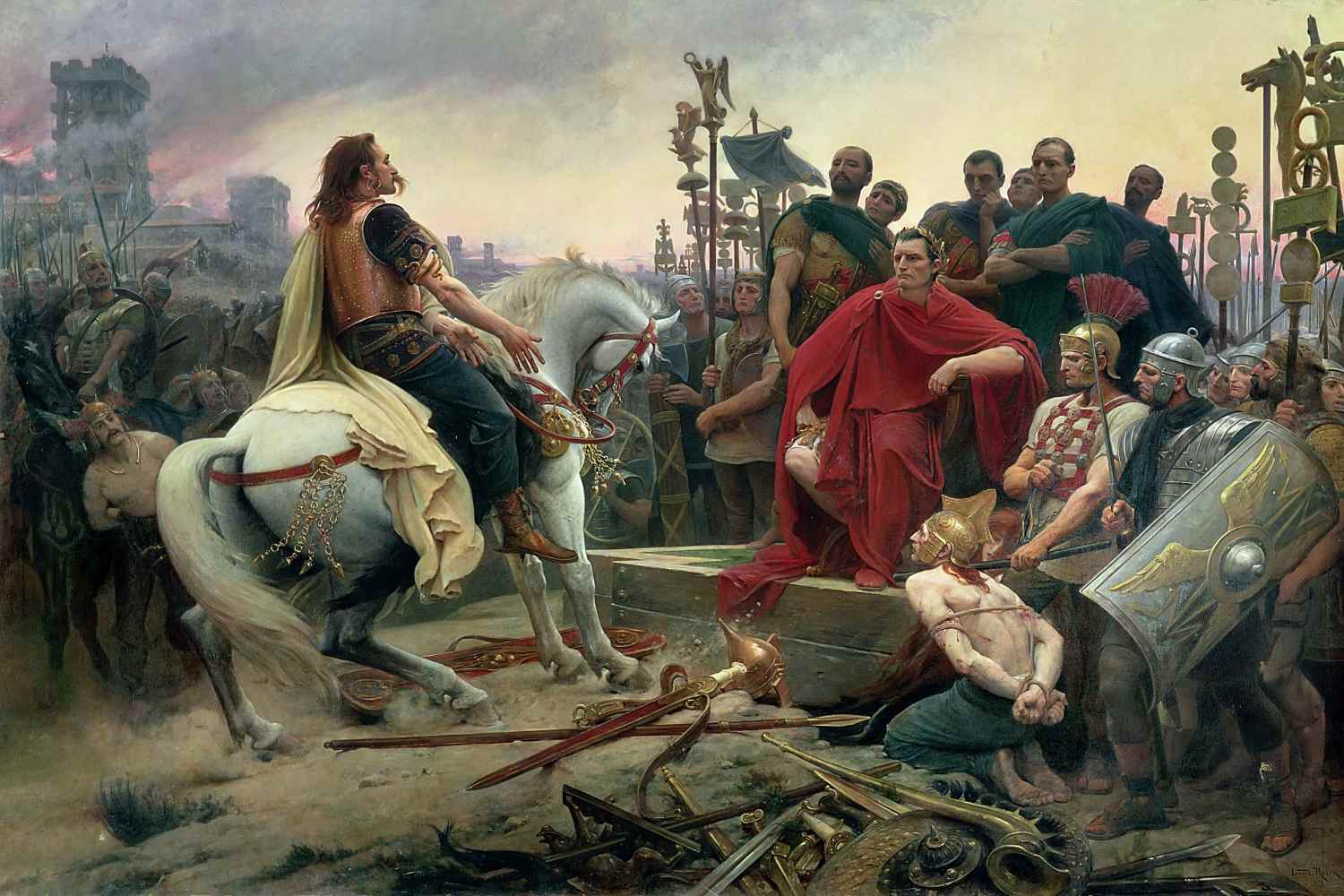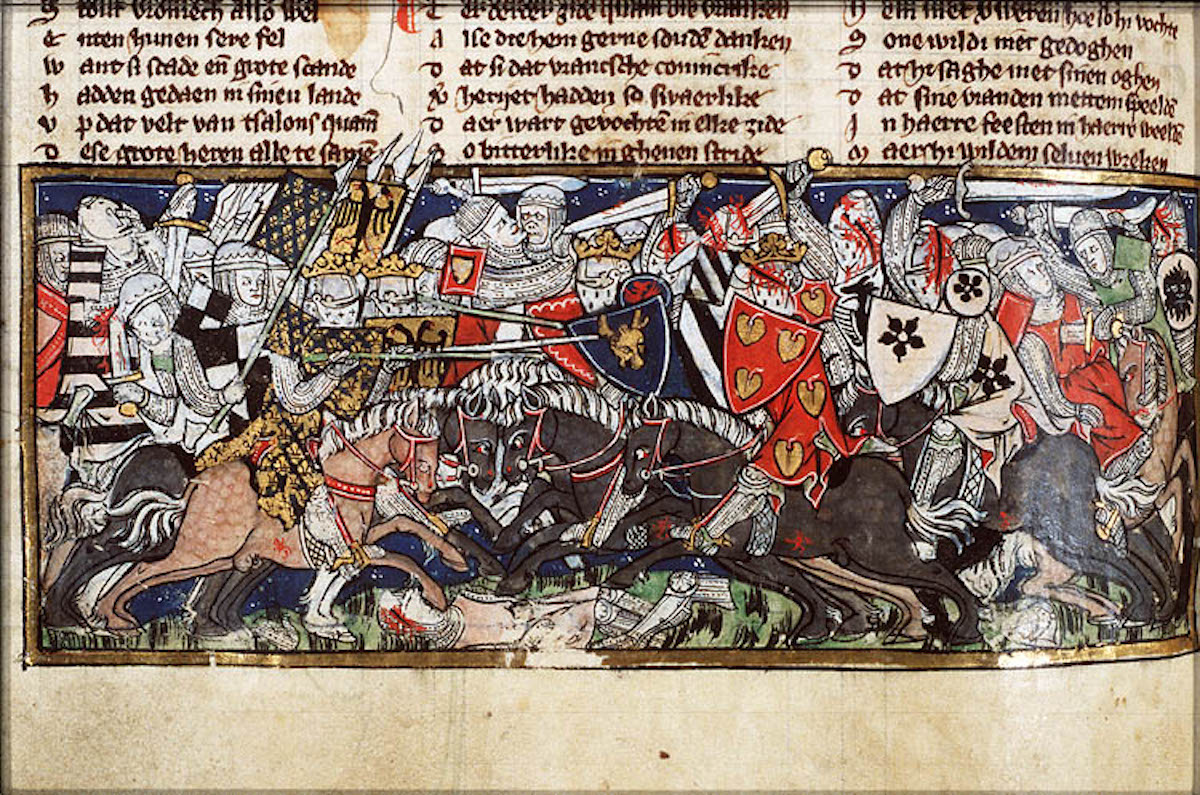A Republic in Full Expansion
125-121 BC: Rome’s legions, led by consul Fluvius Flaccus, intervene in Gaul for the first time in 125 BC, in what is now Provence. They defeat the local Gaulish peoples: the Ligurians, Salyens, and Vocontii. Four years later, consul Fabius Maximus defeats the Allobroges (settled between the Rhône and the Southern Alps). A new Roman province is born: Gallia Transalpina (Transalpine Gaul).
118 BC: Domitius Ahenobarbus establishes the Colonia Narbo Martius (Narbonne). The general and consul turns the city into a commercial crossroads of the western Mediterranean.
102 BC: Fortified in a camp on the Rhône, consul Caius Marius defeats two Germanic-Celtic tribes, the Teutons and Cimbri, at Aquae Sextiae (Aix-en-Provence). These tribes sought to cross the Alps to attack Rome. His triumph halts further foreign invasions on Gaulish soil.
61 BC: Led by their chief Catugnatos, the Allobroges rise again to take control of Transalpine Gaul. The province’s governor, Caius Pomptinus, defeats them at the Battle of Solonion near Valence (Drôme).
58 BC: Wishing to match the military exploits of his rival Pompey (106-48 BC), Julius Caesar (100-44 BC), proconsul of Transalpine Gaul, begins his conquest of “long-haired Gaul” (Gallia Comata), inhabited by powerful tribes like the Arverni (Auvergne), the Aedui (Burgundy), and the Carnutes (Central Loire Valley). Caesar exploits rivalries between these tribes to carry out his Gallic Wars.
52 BC: Upon his return to Rome, crowned with victories, Caesar learns of unrest in Gaul: Roman merchants have been massacred in Cenabum (Orléans) and the Arverni chief Vercingetorix (80-46 BC) has raised an army of 80,000 men. In June, Caesar’s legions lay siege to the oppidum of Gergovia but are defeated by the Gauls. Caesar imposes a two-month siege, from August to September, at Alesia, starving the population. Vercingetorix is forced to surrender. The following year, all of Gaul becomes Roman.
40 BC: After the assassination of Julius Caesar in 44 BC, Rome is divided between his grand-nephew Octavian, generals Lepidus and Mark Antony, who form a triumvirate. They conclude the Pact of Brundisium (Brindisi, Italy), which recognizes Mark Antony as master of the East and Lepidus of Africa. Octavian, the future Emperor Augustus, rules over Gaul.
The Long Reign of Emperor Augustus
27 BC: Founded in 43 BC by proconsul Munatius Plancus, Lugdunum (Lyon) is elevated to the rank of capital of Gaul. The city houses the only mint outside Rome authorized to strike gold and silver coins and becomes the empire’s second aqueduct system.
16-13 BC: Emperor Augustus (63 BC-14 AD) gives Gaul a new administrative framework. Transalpine Gaul, governed by a proconsul, becomes Narbonensis, named after its capital Narbo Martius (Narbonne).
Long-haired Gaul is divided into provinces: the Three Gauls: Belgica with its capital Durocortorum (Reims), Lugdunensis with Lugdunum (Lyon), and Aquitania governed from Mediolanum Santonum (Saintes). Gaulish peoples are grouped into civitates (cities), and their governor is the emperor himself.
12 BC: The imperial cult establishes its first sanctuary in Lugdunum (Lyon) and a second in Narbo Martius (Narbonne). Every year on August 1st, the Council of Gaul, bringing together representatives from the sixty cities of the three provinces, elects a high priest to celebrate Rome and the emperor.
9 AD: Three Roman legions led by General Publius Quinctilius Varus are massacred by the Germans in the Teutoburg Forest (modern-day Germany). The province of Germania slips out of Rome’s control. The Romans consolidate the border on the Rhine but no longer seek to control the area between the Rhine and the Danube, which from the third century will become the starting point of the “barbarian invasions.”
The Julio-Claudians, Heirs of Augustus
21 AD: While Julius Caesar had exempted most Gaulish peoples from taxes, Emperor Tiberius (42 BC-37 AD) demands a tribute from all. Julius Florus, leader of the Treveri (inhabitants of modern-day Belgium), and Julius Sacrovir, leader of the Aedui (in Burgundy), launch a revolt. Defeated by legions returning from Germania, the two members of the old Gaulish aristocracy commit suicide.
48 AD: Emperor Claudius (10 BC-54 AD), born in Lugdunum (Lyon), delivers a remarkable speech in the Senate advocating for Gaulish nobles to be considered full Roman citizens. Only the elites of a few tribes allied with Rome, like the Aedui, will gain this status.
68-69 AD
After the death of Nero (37-68), the last emperor of the Julio-Claudian dynasty, Rome plunges into political chaos, with four usurpers succeeding each other. The Gauls are drawn into this civil war through the governors of the Three Gauls.
Peaceful Rule of the Flavians
70 AD: Under Emperor Vespasian (9-79), the first emperor of the Flavian dynasty, the Pax Romana (Roman Peace) is solidified during an assembly in Durocortorum (Reims), where, “in the name of Gaul,” the Gallo-Roman elites swear loyalty to Rome.
90 AD: During the reign of Emperor Domitian (51-96), the construction of public buildings multiplies in the major Gallo-Roman cities. Amphitheaters are built in Nîmes, Orange, and Arles. A 275-meter-long and 48-meter-high aqueduct, meant to bring water from the Uzès spring to the city of Nemausus (Nîmes), begins to be erected: this will be the future Pont du Gard.
92 AD: Worried about the increase in Gaul’s wine exports, which threatens small Roman vineyards, Domitian orders, by decree, the uprooting of half of Gaul’s vineyards.
Under the Antonines and Severans
177 AD: As Christianity emerges in Gaul, Emperor Marcus Aurelius (121-180), alarmed by this new religion, demands public executions. Among the most notable are 66 martyrs thrown to the wild beasts in the amphitheater of Lugdunum (Lyon).
197 AD: Emperor Septimius Severus (145-211) sacks Lugdunum (Lyon), the capital of Gaul, which had allied with the usurper Clodius Albinus. Gallo-Roman senators are executed.
212 AD: The Constitutio Antoniniana, also known as the Edict of Caracalla, grants Roman citizenship to all free men in the empire who had not yet acquired it.
Third Century Crisis of the Roman Empire
253-274 AD: Abandoned by the empire, plagued by military anarchy, the Gallo-Romans secede to defend against the first “barbarian invasions” from the east. General Postumus seizes Cologne and declares himself “Emperor of the Gauls” in 260, before being assassinated. In 274, Emperor Aurelian (214-275) restores unity. He is killed by the Praetorian Guard a year later.
284-286 AD: Driven into misery, armed bands of landless peasants, slaves, and deserting soldiers, called the “Bagaudae,” loot and plunder northwest Gaul. Emperor Diocletian (245-313) violently suppresses these outcasts of Roman conquest.
303 AD: To weaken the power of governors, Diocletian divides Gaul into sixteen imperial provinces grouped into two districts: Diocesis Galliarum, north of the Loire and Rhône, with Augusta Treverorum (Trier) as its capital, and Diocesis Viennensis, which extends to the southernmost provinces, with Vienna (Vienne) as its capital.
Rise of Christianity
313-392 AD: Emperor Constantine I (272-337) converts to Christianity in 313. Theodosius I (347-395) continues his work with the Edict of Thessalonica in 380, which declares Christianity the official religion of the Roman Empire. He bans all pagan practices in 392.
406 AD: The “barbarian invasions” sweep across Gaul. Vandals, Suebi, and Alans, Germanic tribes, cross the Rhine and destroy everything in their path. Weakened, Emperor Flavius Honorius (384-423) does not intervene.
410 AD: Rome is sacked by the Visigoths of Alaric I. This Germanic people then seizes Narbonensis and Aquitaine in Gaul.
Collapse of the Roman World
476 AD: On September 4, Odoacer, leader of the Heruli, barbarians allied with the Huns of Attila, confronts Romulus Augustulus (461-507), the last emperor of the Western Roman Empire. He deposes him and becomes the first Germanic king of Italy. The Western Empire collapses.
486 AD: The Roman Empire is replaced in Gaul by a Frankish kingdom ruled by Clovis (465-511). From the Merovingians to the Carolingians, a new Gallo-Frankish identity emerges. Roman civilization begins to merge with the “barbarian” world of the Franks, leading to the birth of the French language.





